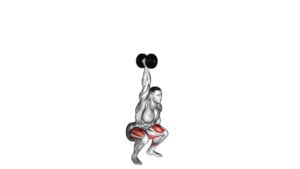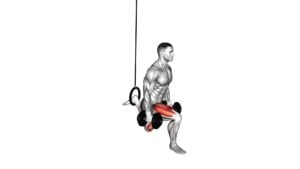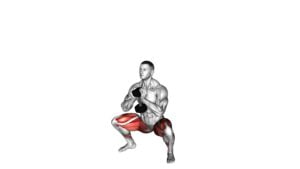Dumbbell Squat – Video Exercise Guide & Tips

Are you looking to level up your workout routine? Look no further than the dumbbell squat.
Watch This Exercise Video
This powerful exercise targets multiple muscle groups, helping you build strength and tone your lower body.
In this video exercise guide, we'll walk you through the proper form and technique, variations to challenge yourself, and common mistakes to avoid.
Get ready to feel the burn and see results with our tips for maximizing your dumbbell squat workout.
Key Takeaways
- Dumbbell squats strengthen the entire lower body, including quadriceps, hamstrings, and glutes.
- Proper form and technique are essential, such as sitting back into the hips and keeping the knees in line with the toes.
- Variations like goblet squats or single-leg squats can be incorporated to challenge oneself and improve balance and stability.
- Avoid common mistakes such as letting knees go past toes, maintaining a neutral spine, breathing correctly, and regularly assessing form to maximize effectiveness and reduce the risk of injury.
Benefits of Dumbbell Squats
One major benefit of dumbbell squats is that they strengthen your entire lower body, including your quadriceps, hamstrings, and glutes. This exercise is highly effective in improving stability and promoting muscle activation. When performing dumbbell squats, you engage multiple muscle groups simultaneously, making it a great compound exercise for overall lower body strength.
Dumbbell squats specifically target your quadriceps, which are the muscles located on the front of your thighs. By incorporating dumbbells into your squats, you increase the resistance and challenge your quadriceps even more. Additionally, your hamstrings, located on the back of your thighs, also get activated during the squat movement. This helps to build strength and stability in your lower body.
Another significant muscle group that benefits from dumbbell squats is your glutes. These are the muscles in your buttocks. Squatting with dumbbells engages your glutes to a greater extent compared to bodyweight squats, resulting in improved muscle activation and development.
Proper Form and Technique
To perform dumbbell squats with proper form and technique, you need to maintain a stable stance and engage your lower body muscles throughout the movement. Here are some tips to help you achieve the correct form and technique:
- Common Misconceptions:
- One common misconception is that you should let your knees go past your toes during the squat. However, this can put unnecessary strain on your knees. Instead, focus on sitting back into your hips while keeping your knees in line with your toes.
- Another misconception is that you should only focus on going as low as possible. While it's important to achieve a full range of motion, make sure you maintain control and stability throughout the movement. Going too low without proper form can lead to injury.
- Modifications for Different Fitness Levels:
- If you're new to squats or have limited mobility, you can start by using just your body weight or holding onto a stable object for support. As you gain strength and confidence, gradually add dumbbells to increase the intensity.
- For those with advanced fitness levels, you can incorporate variations such as goblet squats or single-leg squats. These variations challenge your stability and engage different muscle groups.
Variations to Challenge Yourself
As you progress in your dumbbell squat routine, you can further challenge yourself with various variations that target different muscle groups and enhance your overall stability. These variations are perfect for individuals who've mastered the basic dumbbell squat and are looking to take their workout to the next level.
One way to increase the difficulty of the dumbbell squat is by adding weight. You can do this by gradually increasing the amount of weight you use or by using heavier dumbbells. This will help you to build strength and endurance as you progress through different progression levels.
Another variation to challenge yourself is by incorporating equipment options such as a stability ball or a Bosu ball. These tools add an element of instability to the exercise, forcing your muscles to work harder to maintain balance. This not only targets your leg muscles, but also engages your core and improves your overall stability.
Furthermore, you can try performing single leg dumbbell squats. This variation places more emphasis on each leg individually, helping to improve balance and stability while also increasing the intensity of the exercise. It's important to start with lighter weights and gradually increase the load as you become more comfortable and confident with this variation.
Incorporating these variations into your dumbbell squat routine won't only challenge your muscles in new ways but also help you to progress in your fitness journey. Remember to always listen to your body and start with lighter weights or modifications if needed.
Common Mistakes to Avoid
To avoid common mistakes, regularly assess your form while performing the dumbbell squat. Proper positioning is crucial to ensure you're targeting the right muscles and avoiding injury. Here are some common mistakes to avoid:
- Allowing your knees to go past your toes: This puts excessive strain on your knee joints. Make sure to push your hips back and lower your body by bending your knees while keeping them in line with your toes.
- Arching your back: Maintaining a neutral spine is essential for proper form. Avoid arching your back by engaging your core muscles and focusing on keeping your chest lifted throughout the movement.
- Forgetting to breathe: Breathing correctly can enhance your performance and prevent dizziness or lightheadedness. Inhale as you lower yourself into the squat and exhale as you push back up.
By avoiding these common mistakes and maintaining proper form, you can maximize the effectiveness of your dumbbell squat and reduce the risk of injury.
Now, let's move on to some tips for maximizing your results.
Tips for Maximizing Your Results
To maximize your results with the dumbbell squat, focus on proper form and incorporate these tips. Avoid making the mistakes we discussed earlier, as they can hinder your progress and potentially lead to injury. By maintaining proper form, you can reap the benefits of this exercise and achieve optimal results.
One of the main benefits of performing the dumbbell squat with proper form is that it targets multiple muscle groups simultaneously. This compound exercise engages your quadriceps, hamstrings, glutes, and core. By utilizing these large muscle groups, you can increase your overall strength and burn more calories during your workout.
Another key benefit of proper form is that it helps to prevent injury. When you maintain a neutral spine and engage your core, you provide stability and support to your back. This reduces the risk of straining your lower back or experiencing other related injuries. Additionally, by keeping your knees aligned with your toes and avoiding excessive forward lean, you can protect your knees from unnecessary stress.
Incorporating these tips into your dumbbell squat routine can help you maximize your results and prevent potential setbacks. Remember to focus on proper form, avoid the mistakes we discussed earlier, and always listen to your body. With consistency and dedication, you'll be able to achieve your fitness goals and see the progress you desire.
Frequently Asked Questions
How Heavy Should the Dumbbells Be for a Beginner Starting Out With Dumbbell Squats?
When starting out with dumbbell squats, it's important to choose the right weight to avoid injury and ensure proper form. As a beginner, you should opt for lighter dumbbells that you can comfortably lift and control.
This will allow you to focus on mastering the exercise technique and gradually increase the weight as you get stronger. Remember to consult with a fitness professional to determine the appropriate weight for your fitness level and goals.
Can Dumbbell Squats Help in Reducing Belly Fat?
Dumbbell squats are a great exercise for overall fitness and can help in reducing belly fat. By incorporating dumbbell squat variations into your workout routine, you can target your lower body muscles, including your glutes, quads, and hamstrings.
This exercise also engages your core, which can help strengthen and tone your abdominal muscles.
Are Dumbbell Squats Suitable for People With Knee Problems?
Dumbbell squats can be a great exercise for building strength and toning your lower body. However, if you have knee problems, it's important to modify the exercise to avoid any pain or discomfort.
There are several modifications you can try, such as using lighter weights, reducing the range of motion, or using a stability ball for support.
Additionally, there are alternative exercises you can incorporate into your routine that are less stressful on the knees, such as lunges or step-ups.
How Often Should Dumbbell Squats Be Incorporated Into a Fitness Routine?
To properly incorporate dumbbell squats into your fitness routine, it's important to consider the incorporation frequency and proper form.
Dumbbell squats are a great exercise for building strength and toning your lower body.
Incorporate them into your routine two to three times a week for optimal results.
Remember to maintain proper form by keeping your back straight, knees in line with your toes, and lowering yourself into a squat position until your thighs are parallel to the ground.
Can Dumbbell Squats Help in Improving Posture?
Dumbbell squats are a great exercise to improve posture. By incorporating dumbbell squats into your fitness routine, you can work on improving balance and increasing leg strength.
This exercise helps to engage your core muscles and promotes proper alignment of your spine. By regularly performing dumbbell squats, you can strengthen the muscles that support your posture and help you maintain a more upright position throughout the day.
Conclusion
In conclusion, incorporating dumbbell squats into your workout routine can offer a wide range of benefits. This includes increased strength, muscle growth, and improved stability.
By focusing on proper form and technique, you can maximize the effectiveness of this exercise and avoid common mistakes. It's important to maintain a neutral spine, keep your feet shoulder-width apart, and lower your hips until your thighs are parallel to the ground.
Don't be afraid to challenge yourself with variations to keep your workouts interesting and continue progressing. This can include adding more weight to the dumbbells, using a stability ball, or trying single-leg squats.
Remember to always listen to your body and make adjustments as needed. If you feel any pain or discomfort, it's important to modify the exercise or consult a fitness professional.
Keep pushing yourself and enjoy the results!

Author
Years ago, the spark of my life’s passion ignited in my mind the moment I stepped into the local gym for the first time. The inaugural bead of perspiration, the initial endeavor, the very first surge of endorphins, and a sense of pride that washed over me post-workout marked the beginning of my deep-seated interest in strength sports, fitness, and sports nutrition. This very curiosity blossomed rapidly into a profound fascination, propelling me to earn a Master’s degree in Physical Education from the Academy of Physical Education in Krakow, followed by a Sports Manager diploma from the Jagiellonian University. My journey of growth led me to gain more specialized qualifications, such as being a certified personal trainer with a focus on sports dietetics, a lifeguard, and an instructor for wellness and corrective gymnastics. Theoretical knowledge paired seamlessly with practical experience, reinforcing my belief that the transformation of individuals under my guidance was also a reflection of my personal growth. This belief holds true even today. Each day, I strive to push the boundaries and explore new realms. These realms gently elevate me to greater heights. The unique combination of passion for my field and the continuous quest for growth fuels my drive to break new ground.







